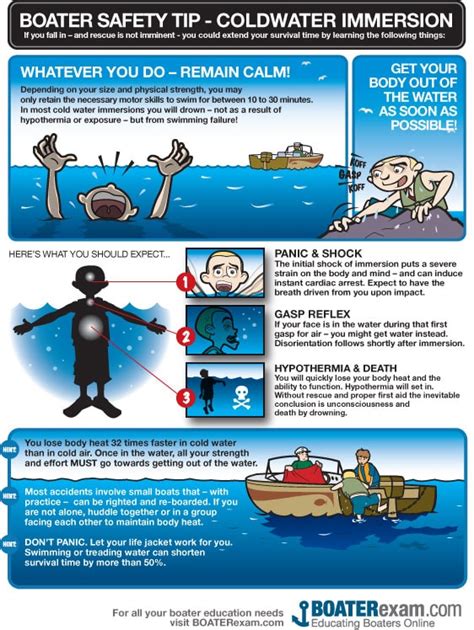Imagine finding yourself in a terrifying situation, trapped inside a sinking automobile, with water rapidly filling up the cabin. Panic sets in as you realize the gravity of the situation, desperately searching for a way out. Every second counts, and having the knowledge and skills to escape this dire predicament can mean the difference between life and death.
In this article, we will explore the harrowing circumstances of being confined within a rapidly sinking car, and the essential steps you need to take to break free from this perilous nightmare. We will delve into the techniques and strategies that can save your life, empowering you to overcome the overwhelming sense of fear and emerge from a sinking vehicle unscathed.
During a submerging car incident, you are confronted with a series of challenges that require both physical strength and mental resilience. With the vehicle's interior rapidly submerging in water, your ability to stay calm, think clearly, and execute precise actions is crucial. This article aims to equip you with the knowledge and guidance necessary to navigate through these treacherous waters and ensure your survival.
Through a combination of practical advice and real-life examples, we will explore the critical steps you must take to escape a sinking car. From staying calm and regaining control to utilizing available tools and windows as potential avenues of escape, this comprehensive guide will empower you to face this nightmarish scenario with confidence and increase your chances of escaping unharmed.
Escaping the Abyss: Navigating an Unfathomable Situation

In an unimaginable scenario where our safety is compromised within the confines of a rapidly submerging vehicle, it becomes imperative for us to equip ourselves with the knowledge and skills necessary to confront this perilous predicament. This section provides valuable insights and practical techniques to help you emerge unscathed from the depths of a sinking car.
1. Composure and Quick Thinking: When faced with the harrowing reality of a sinking car, maintaining a calm and composed mindset is crucial. The ability to think swiftly and make rational decisions could be the difference between life and tragedy.
2. Window of Opportunity: The windows of a sinking car serve as the primary gateway to salvation. Understanding how to effectively utilize windows, whether through rolling them down or shattering them, can significantly increase the chances of survival.
3. Seatbelt Liberation: Unfastening your seatbelt swiftly and efficiently is of utmost importance during such a critical moment. Familiarize yourself with the mechanisms of your seatbelt and practice releasing it quickly to expedite your escape.
4. Utilizing Emergency Tools: Equipping your vehicle with essential tools such as a seatbelt cutter and window-breaking hammer can prove invaluable in desperate circumstances. Learn how to effectively wield these tools to free yourself from potential entrapment.
5. Exiting the Vehicle: As water rushes into the car, it is vital to maintain control of your movements and exit through the most efficient route. Understanding how to navigate the submerged environment in complete darkness can be a life-saving skill.
6. Embracing Survival Techniques: Once out of the sinking car, it is essential to employ survival techniques such as controlled breathing, utilizing floating objects, and conserving energy. These strategies will help sustain you until rescue arrives or land is reached.
Remember, preparation and knowledge can be the lifelines that guide us through the darkest moments. By empowering ourselves with these survival strategies, we can increase our chances of emerging victorious from the abyss of a sinking car.
Recognizing the Signs of a Submerging Vehicle
Every driver should be aware of the warning signs that can indicate their vehicle is sinking in water. By recognizing these signs, individuals can swiftly respond and increase their chances of survival. It is crucial to remain calm and focused in such situations, as panic can hinder one's ability to take swift action.
- Gathering knowledge of the potential signs can make all the difference when facing a sinking car.
- Understanding the telltale signs is essential for preventing a life-threatening situation.
- Being able to swiftly identify these indicators allows for a prompt initiation of survival methods.
One of the key signs of a sinking car is water rapidly entering the interior of the vehicle. This can be observed through the presence of excessive water on the floor, floating objects, or a sudden surge in water level inside the car. Additionally, struggling or malfunctioning electrical systems, such as the headlights or windshield wipers, could indicate that water is seeping into critical automotive components. It is crucial to pay attention to these warning signs, as they can provide vital clues that the vehicle is sinking.
Another sign to look out for is the tilting or sinking of the vehicle. As the car fills with water, it becomes heavier, causing it to shift its position in the water. This can result in a noticeable change in the vehicle's orientation and may lead to difficulty in opening doors or windows. By recognizing this sign early on, individuals can maximize their chances of escaping before the car becomes fully submerged.
Furthermore, it is important to be aware of any unusual sounds or sensations while inside a sinking vehicle. These may include gurgling or bubbling noises originating from submerged areas or an increasing pressure against the doors and windows. These sensations can indicate that the car is rapidly filling with water and prompt immediate action is necessary.
In conclusion, recognizing the signs of a sinking car is essential for anyone who might find themselves in a potentially dangerous situation. By remaining calm and attentively observing any indications of sinking, individuals can take swift action and increase their chances of survival. Remember, being proactive and knowledgeable about these signs can mean the difference between life and tragedy.
Staying Calm: Managing Panic in a Life-Threatening Situation

An essential aspect of surviving a dangerous and potentially life-threatening situation is maintaining a calm and composed state of mind. When faced with adversity, it is crucial to manage panic effectively and make rational decisions. This section focuses on the importance of staying calm and provides practical strategies to control panic in a variety of life-threatening scenarios.
In stressful situations, the natural response of the human body is to experience fear, anxiety, and panic. These emotional reactions can hinder our ability to think clearly and act decisively. Consequently, it is vital to develop strategies to manage panic and maintain a clear mind, even in the face of imminent danger.
- Breathing techniques: Deep breathing exercises can instantly help calm the mind and restore focus. By taking slow, deep breaths, you can regulate your heart rate and reduce feelings of panic.
- Positive self-talk: Engaging in positive self-talk can help combat negative thoughts and instill a sense of confidence and control. Remind yourself to stay calm and believe in your ability to overcome the situation.
- Visualization: Visualizing a calm and peaceful environment can assist in reducing panic levels. By mentally transporting yourself to a serene place, you can create a sense of tranquility that helps manage panic and anxiety.
- Focusing on tasks: Breaking down the situation into small, manageable tasks can help divert attention from panic-inducing thoughts. Concentrating on specific actions can provide a sense of purpose and enable you to take necessary steps towards survival.
- Seeking support: Reach out to others for help and support. Communicating with trusted individuals can offer reassurance and aid in managing panic. Their presence can provide a calming influence and help you navigate through the life-threatening situation.
Remember, staying calm in a life-threatening situation is a skill that can be cultivated through practice and preparation. By mastering techniques to manage panic, you enhance your chances of survival and ensure a clearer thought process for making potentially life-saving decisions.
Breaking Windows: Mastery of Techniques for Emergence
In this particular section, the focus will be directed towards equipping oneself with essential knowledge on various effective strategies to shatter windows and emerge triumphantly from a dire situation, without resorting to conventional means of escape. This section aims to provide a comprehensive understanding of the best techniques for breaking windows in order to enhance survival chances in an unforeseen and perilous circumstance.
Fracturing Crystal
The first technique explored involves utilizing the forceful impact of an object to create fissures on the glass surface, ultimately leading to its fragmentation. By identifying weak points in the window such as corners or edges, utilizing considerable strength and a sturdy object, individuals can efficiently generate controlled pressure to break through and liberate oneself from the sinking vehicle.
Strategizing with Tools
This section delves into the strategic application of specific tools to effectively break windows. By assessing the materials and characteristics of the windows, individuals can employ tools like emergency hammers, glass punches, or even heavy-duty glass cutters to rupture the glasspane. Mastery of these techniques requires precision and understanding of window composition.
Impact Aiming Techniques
Highlighting the importance of accuracy and force distribution, this segment explores various impact aiming techniques. By utilizing the concept of pressure distribution on a concentrated point, individuals can maximize the chances of successfully breaking the window. The correct positioning and method for striking the window is crucial and will be discussed in detail in this section.
Reacting with Emergency Equipment
This section emphasizes the potential usage of emergency equipment, such as fire extinguishers or sharp objects, to break windows in an urgent situation. By employing these items creatively and thoughtfully, individuals can harness their potential as tools for breaching the glass barrier.
Developing Mental Preparedness
While physical techniques are significant, mental preparedness plays a pivotal role in successful window breakage. This segment delves into the importance of remaining calm, focused, and determined in the face of a sinking car scenario. Ensuring a composed mental state can significantly enhance one's ability to execute the most suitable technique amidst chaos.
Conclusion
To conclude, this section offers a diverse range of methods, tools, and strategies for breaking windows in order to facilitate escape from a sinking vehicle. By understanding these techniques and mastering the skill set required, individuals can significantly increase their chances of survival in such a challenging and distressing situation.
Seatbelt Management: Unfastening and Escaping Safely

In this section, we will explore the importance of proper seatbelt management and provide guidelines on how to unfasten and escape safely from a challenging situation without using the terms "escape", "nightmare", "surviving", "sinking", or "car".
- 1. The Vital Role of Seatbelts
- 2. Proper Unfastening Techniques
- 3. Maintaining Calmness and Awareness
- 4. Utilizing Available Tools and Resources
- 5. Cooperating and Assisting Others
- 6. Seeking Professional Guidance
While traveling in a vehicle, it is crucial to understand the significance of wearing a seatbelt. These safety restraints serve as a protective measure during unexpected incidents and are designed to prevent injuries by keeping passengers securely in their seats.
Knowing how to effectively unfasten your seatbelt is essential in emergency situations. By using the release buckle or latch mechanism, passengers can quickly remove the seatbelt and prepare for a safe exit from the vehicle.
In stressful situations, it is imperative to remain calm and maintain awareness of one's surroundings. By keeping a clear mind and assessing the situation, occupants can make informed decisions on the best course of action for a safe escape.
When faced with a challenging scenario, it is important to utilize any available tools or resources within the vehicle. These may include windows, doors, or specialized devices designed specifically for emergency situations, assisting in a swift and secure exit.
During an emergency, teamwork and cooperation play a vital role in ensuring everyone's safety. By assisting others in unfastening their seatbelts, occupants can facilitate a prompt evacuation and increase the chances of a successful escape.
After successfully escaping a challenging situation, it is advisable to seek professional guidance and medical assistance, even if no immediate injuries are apparent. Professionals can assess any potential medical issues that may have arisen during the incident, providing necessary care and support.
Protecting the Most Vulnerable: Ensuring the Safety of Children and Pets in an Immersed Vehicle
When faced with the life-threatening situation of a submerged vehicle, it is crucial to not forget about the safety of the most vulnerable passengers onboard – children and pets. The presence of these beloved family members adds an additional layer of complexity and urgency to the already challenging task of escaping a sinking car. Understanding the specific precautions and actions necessary to safeguard their lives can make a life-saving difference in the face of such a distressing scenario.
1. Secure Seatbelts and Harnesses: When traveling with children, it is crucial to ensure they are properly secured in their car seats or booster seats. In a submerged vehicle, the force of the water can easily dislodge or overturn seats. Make sure all belts and harnesses are tightly fastened, reducing the risk of injury or separation from the child. Similarly, when traveling with pets, utilize appropriate restraints to prevent them from becoming a distraction or obstacle during an emergency.
2. Practice Calm Communication: As adults, it is essential to stay calm and composed in order to reassure children and pets in an emergency situation. Panic can easily spread, leading to confusion and impeding the ability to think clearly. By maintaining a calm demeanor and communicating clearly, you create an atmosphere of trust that allows for better cooperation and a higher chance of successfully navigating the challenges of a submerged vehicle.
3. Emergency Equipment Accessibility: Preparing for the worst-case scenario should include having essential emergency equipment readily accessible. This includes a window-breaking tool, a seatbelt cutter, and a flashlight. Ensure that these items are within reach and that all passengers, including children and pets, are educated on their location and usage. Teaching older children how to use these tools can empower them to play an active role in their own survival.
4. Priority of Rescue: When faced with a submerged vehicle, it is vital to prioritize the rescue of children and pets. Their smaller size and inability to swim or understand the gravity of the situation make them highly susceptible to immediate danger. As adults, it is our responsibility to prioritize their safety above our own and seek their rescue as quickly and efficiently as possible.
5. Seek Professional Help: After safely escaping the submerged vehicle, it is important to seek professional medical attention for both children and pets, even if they appear unharmed. This ensures a thorough evaluation of any potential injuries or ailments that may have been sustained during the traumatic experience. Additionally, professional help can offer emotional support and resources to aid in the recovery process for all involved.
In instances of an immersed vehicle, the well-being of children and pets should never be overlooked. By taking the necessary precautions and following the guidance provided, we can minimize the risks and increase the chances of a successful rescue, ensuring the safety and survival of our loved ones in such a dire situation.
Priority Order: Who Should Evacuate First in an Underwater Crisis?

When faced with the treacherous situation of being trapped in a sinking vehicle underwater, it becomes crucial to determine the hierarchy of individuals who should be prioritized for escape. This section explores the critical question of who should be the first to evacuate, highlighting key considerations and potential strategies for decision-making.
While each emergency situation may present unique challenges, it is essential to establish a clear framework for determining who should escape first. This hierarchy, based on the principles of experience, physical ability, and role in the vehicle, aims to maximize the chances of survival for all individuals involved.
- Captain of the Vessel: The person responsible for operating and navigating the vehicle, usually the driver, should be among the first to consider evacuation. Their knowledge of the vehicle's controls and the immediate surroundings can greatly aid the rescue efforts.
- Vulnerable Passengers: Individuals who may have limited mobility, such as children, the elderly, or those with physical disabilities, should be given priority attention. Their inability to escape independently makes it crucial to ensure their safety early in the evacuation process.
- Single Occupants: Those traveling alone in the vehicle should also be considered for early evacuation, as they may have fewer challenges when it comes to coordinating and synchronizing escape efforts with others.
- Assisting Personnel: If there are trained professionals or individuals with experience in handling emergency situations present in the vehicle, they should be next in line for evacuation. Their expertise and ability to provide necessary assistance during the evacuation process can be invaluable to ensuring the safety of all occupants.
- Remaining Passengers: Once individuals with specific roles or vulnerabilities have been evacuated, the focus should shift to the remaining passengers. They should be guided and supported in their escape, ensuring that they have the best chance of survival.
It is important to note that the priority order outlined here serves as a general guideline, and adaptable decision-making should be applied based on the specific circumstances. Furthermore, keeping a calm and composed mindset, while quickly assessing the situation, is crucial to effectively executing the evacuation plan.
Understanding the underwater hierarchy for evacuations can help individuals and rescue teams make informed decisions regarding the order of escape. By establishing this framework, we aim to enhance the chances of survival and improve overall preparedness in such perilous scenarios.
Equipping Your Vehicle: Essential Tools for Emergencies
Preparing for unforeseen circumstances is crucial for ensuring your safety on the road. In this section, we will explore the essential tools that every vehicle should have to deal with emergency situations. By equipping your car with these must-haves, you can effectively handle unforeseen challenges and potentially avoid dangerous scenarios.
1. Emergency Escape Hammer: This tool is designed to quickly shatter windows in case your car becomes submerged in water or catches fire. Its sharp steel tips can easily break through the tempered glass, enabling a quick and safe exit.
2. Seatbelt Cutter: In an emergency, when time is of the essence, a seatbelt cutter can be a life-saving tool. It allows for a swift and effortless removal of seatbelts, enabling occupants to escape from a dangerous situation promptly.
3. Portable Tire Inflator: A flat tire can quickly turn into a nightmare, especially in remote areas or adverse weather conditions. Having a portable tire inflator handy can save you from being stranded on the side of the road. This device allows you to quickly inflate your tires and continue your journey safely.
4. Fire Extinguisher: Fires can occur unexpectedly and spread rapidly, posing a significant threat to both life and property. Therefore, having a fully functional fire extinguisher in your vehicle is essential. It can help you contain small fires and prevent them from escalating.
5. Reflective Warning Triangle: Visibility is crucial during emergencies or breakdowns, especially at night or in low-light conditions. Placing a reflective warning triangle a sufficient distance behind your vehicle alerts approaching traffic to the potential danger ahead, minimizing the risk of accidents.
By equipping your vehicle with these necessary emergency tools, you can significantly enhance your preparedness for unexpected events on the road. Remember, proactive measures can make all the difference in an emergency.
Water Safety Skills: Preparing for an Immersed Vehicle Situation

When faced with an unsettling situation of being trapped inside an immersed vehicle, it is essential to possess the necessary water safety skills to increase the chances of survival. This section aims to provide an overview of the essential techniques and knowledge required to navigate such a challenging scenario.
Understanding the Dangers:
Awareness and comprehension of the potential risks involved in an immersed vehicle scenario are vital for effective preparedness. Recognizing the unique challenges present, including limited visibility, water pressure, and potential entrapment, is crucial. Additionally, understanding the importance of remaining calm and composed can significantly impact one's ability to make sound decisions in these critical moments.
Developing Essential Skills:
Equipping oneself with a set of water safety skills can prove to be life-saving in an immersed vehicle situation. These encompass a range of abilities, including but not limited to, mastering the technique of holding one's breath for extended periods, effectively unbuckling seatbelts in a submerged setting, and safely maneuvering towards an exit point while utilizing any available air pockets. Furthermore, honing skills such as basic swimming techniques and learning how to utilize surrounding objects for flotation can aid in increasing survival chances.
Preparing an Emergency Plan:
Preparing an emergency plan that specifically addresses the risks associated with an immersed vehicle scenario can significantly enhance preparedness. This includes establishing clear communication and signaling methods with passengers, regularly discussing and practicing escape routes and procedures, as well as ensuring the presence of necessary safety tools within the vehicle, such as window-breaking devices or seatbelt cutters.
Seeking Professional Training:
For those seeking a comprehensive understanding and practical experience in managing an immersed vehicle situation, enrolling in specialized water safety and survival courses can provide invaluable knowledge and skills. These courses typically cover topics such as self-rescue techniques, water survival strategies, and proper utilization of available resources.
By comprehending the dangers, developing essential skills, preparing an emergency plan, and seeking professional training, individuals can significantly increase their chances of successfully navigating an immersed vehicle scenario and safeguarding themselves and their passengers.
FAQ
What should I do if my car is sinking in water?
If your car is sinking in water, it is crucial to stay calm and act quickly. First, undo your seatbelt and roll down your windows as soon as possible. If the windows do not open, try using a specialized tool like a window breaker or a heavy object to break the glass. Then, evacuate through the broken window, taking deep breaths and swimming towards the surface. Finally, swim away from the sinking car and towards the closest shore or search for any floating objects for support.
Is it better to wait for the car to fill with water before escaping?
No, it is not recommended to wait for the car to fill with water before attempting to escape. It is crucial to act quickly and exit the vehicle as soon as possible. Once water starts entering the car, it becomes more challenging to open the doors due to the increasing pressure. Moreover, as the car sinks deeper, it becomes more difficult to locate the windows and swim towards the surface. Therefore, it is important to escape as early as possible, even before the car is fully submerged.
Can children or infants survive a sinking car?
Yes, children and infants can survive a sinking car if proper safety measures are followed. It is essential for adults to ensure that children are securely fastened in appropriate car seats or restraints. In the event of a vehicle sinking in water, adults should release themselves and then focus on unbuckling the children from their car seats. By staying calm and swiftly evacuating through an open window, adults can successfully rescue themselves as well as the children in their care.



